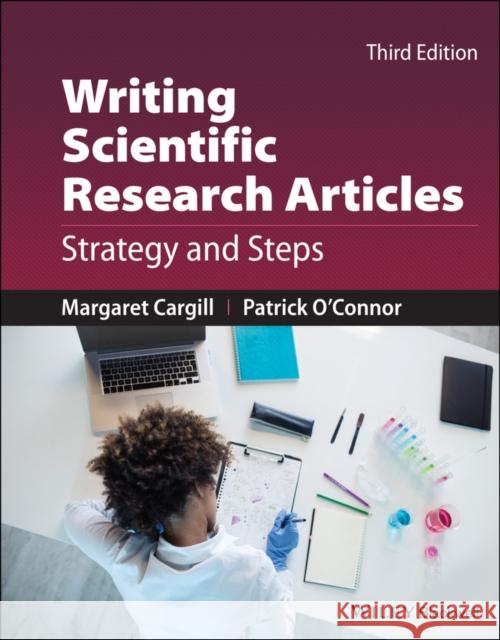Writing Scientific Research Articles: Strategy and Steps » książka



Writing Scientific Research Articles: Strategy and Steps
ISBN-13: 9781119717270 / Angielski / Miękka / 2021 / 256 str.
Writing Scientific Research Articles: Strategy and Steps
ISBN-13: 9781119717270 / Angielski / Miękka / 2021 / 256 str.
(netto: 136,12 VAT: 5%)
Najniższa cena z 30 dni: 142,04
ok. 30 dni roboczych
Dostawa w 2026 r.
Darmowa dostawa!
Preface to the third edition ixPreface to the second edition xiPreface to the first edition xiiiSection 1: A framework for success 11 How to use this book 31.1 Getting started with writing for international publication 31.2 Publishing in the international literature 41.3 Aims of the book 81.4 How the book is structured 91.5 How to use this book if you are. . . 102 Research article structures 132.1 Conventional article structures: AIMRaD and its variations 133 Reviewers' criteria for evaluating manuscripts 193.1 Titles as content signposts 20Section 2: When and how to write each article section 234 Results as a "story": the key driver of an article 255 Results: turning data into knowledge 275.1 Designing figures 285.2 Designing tables 305.3 Figure legends and table titles 315.4 Supplementary material 335.5 Archiving data 346 Writing about results 356.1 Structure of Results sections 356.2 Functions of Results sentences 366.3 Verb tense in Results sections 367 The Methods section 397.1 Purpose of the Methods section 397.2 Organising Methods sections 407.3 Methods in supplementary material 417.4 Publishing methods papers 417.5 Use of passive and active verbs 418 The Introduction 478.1 Argument stages towards a compelling Introduction 478.2 Stage 1: Locating your project within an existing field of scientific research 508.3 Using references in Stages 2 and 3 518.4 Avoiding plagiarism when using others' work 548.5 Stage 3: Indicating the gap or research niche 558.6 Stage 4: The statement of purpose or main activity 568.7 Stages 5 and 6: Highlighting benefit and mapping the article 578.8 Suggested process for drafting an Introduction 578.9 Editing for logical flow 589 The Discussion section 639.1 Important structural issues 639.2 Information elements to highlight the key messages 649.3 Negotiating the strength of claims 6610 The title and keywords 6910.1 Strategy 1: Provide as much relevant information as possible, but be concise 6910.2 Strategy 2: Use carefully chosen keywords prominently 6910.3 Strategy 3: Choose strategically - noun phrase, statement, or question? 7010.4 Strategy 4: Avoid ambiguity in noun phrases 7111 The Abstract and highlights 7311.1 Why Abstracts are so important 7311.2 Selecting additional keywords 7311.3 Abstracts: typical information elements 7311.4 Visual abstracts 7511.5 "Highlights" and other significance or summary sections 7512 Writing review articles 7712.1 What editors want to publish 7912.2 The "take-home message" of a review 7912.3 The structure of review articles 8712.4 Visual elements in review articles: tables, figures, and boxes 8912.5 Checklist for review article manuscripts 9112.6 Systematic review articles 9112.7 Submission and revision of review articles 93Section 3: Getting your manuscript published 9513 Submitting a manuscript 9713.1 Five practices of successful authors 9713.2 Understanding the peer-review process 9813.3 Understanding the editor's role 9913.4 The contributor's covering letter 9913.5 Understanding the reviewer's role 10113.6 Understanding the editor's role (continued) 10314 How to respond to peer reviews 10514.1 Rules of thumb for responding to reviews 10514.2 How to deal with manuscript rejection 10614.3 How to deal with "conditional acceptance" or "revise and resubmit" 10615 A process for preparing a manuscript 11515.1 Manuscript mapping 11615.2 Editing procedures 11715.3 A pre-review checklist 120Section 4: Developing your writing and publication skills further 12116 Skill-development strategies for groups and individuals 12316.1 Journal clubs 12316.2 Writing groups 12416.3 Selecting feedback strategies for different purposes 12416.4 Becoming a reviewer 12616.5 Training for responding to reviewers 12717 Developing discipline-specific English skills 12917.1 Editor expectations of language use 12917.2 Strategic (and acceptable!) language re-use: sentence templates 13017.3 More about noun phrases 13317.4 Concordancing: a tool for developing your discipline-specific English 13417.5 Using the English articles (a/an, the) appropriately in science writing 13817.6 Using "which" and "that" 14118 Writing funding proposals 14318.1 A process for preparing and submitting a funding proposal 14418.2 Easy mistakes to make 147Section 5: Provided example articles 14919 PEA1: Kaiser et al. (2003) 15120 PEA2: Britton-Simmons & Abbott (2008) 16521 PEA3: Ganci et al. (2012) 177Answer pages 191Appendix: Measures of journal impact and quality 221A.1 Journal impact 221A.2 Using indices of journal quality 222References 225Index 229
Margaret Cargill is an applied linguist with over 25 years of experience as a research communication educator. Her research focuses on innovative collaborative methods for helping scientists develop high-level skills for communicating their research findings effectively. She has worked extensively in Australia, Europe, and Asia with scientists of many disciplines and language and cultural backgrounds.Patrick O'Connor is a research ecologist, environmental economist, environmental consultant, and science educator. His work over the last 20 years has focused on the use of scientific principles in designing, monitoring, and evaluating environmental programs for governments and statutory authorities in Australia. His research interests and scientific publications span fields of ecosystem service economics, terrestrial ecology, and detection of change in plant and animal communities.
1997-2025 DolnySlask.com Agencja Internetowa
KrainaKsiazek.PL - Księgarnia Internetowa









